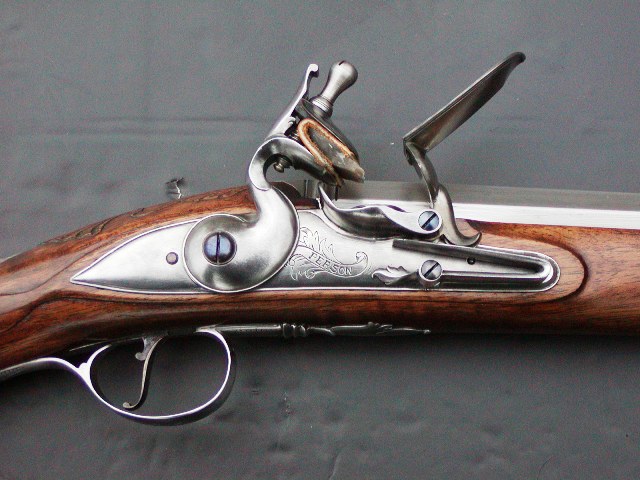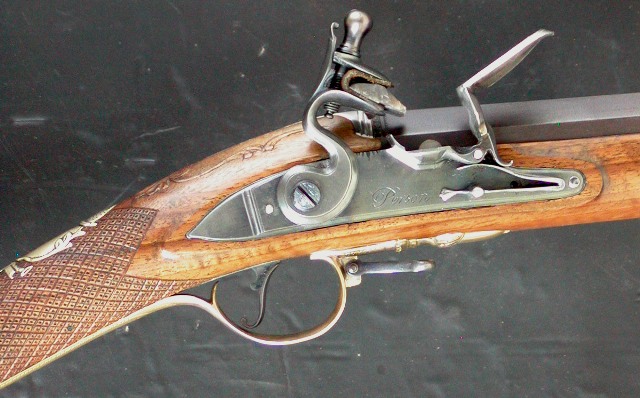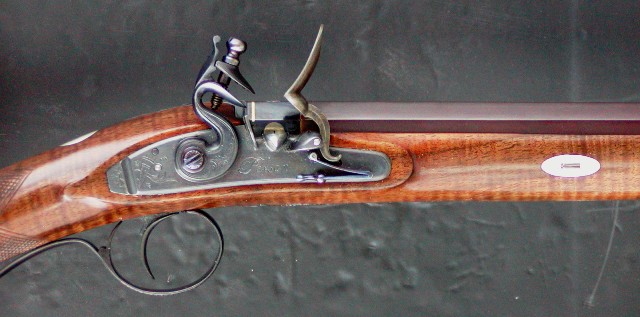-
Friends, our 2nd Amendment rights are always under attack and the NRA has been a constant for decades in helping fight that fight.
We have partnered with the NRA to offer you a discount on membership and Muzzleloading Forum gets a small percentage too of each membership, so you are supporting both the NRA and us.
Use this link to sign up please; https://membership.nra.org/recruiters/join/XR045103
You are using an out of date browser. It may not display this or other websites correctly.
You should upgrade or use an alternative browser.
You should upgrade or use an alternative browser.
R E Davis Twigg lock
- Thread starter excess650
- Start date

Help Support Muzzleloading Forum:
This site may earn a commission from merchant affiliate
links, including eBay, Amazon, and others.
- Joined
- Nov 26, 2005
- Messages
- 5,224
- Reaction score
- 10,884
Hi,
The Davis Twigg lock is a mediocre lock. The tumbler hole is too far to the rear such that the flintcock does not overhang the pan very far when the **** is at rest. The mainsprings are usually weak and need to be reshaped, hardened, and tempered. It is a poor representation of the British locks of that period (1770-1785). Unfortunately, nobody makes a good English lock for the period 1765-1785. The Chambers and Kibler Ketland locks are later (1795-1815).
dave
The Davis Twigg lock is a mediocre lock. The tumbler hole is too far to the rear such that the flintcock does not overhang the pan very far when the **** is at rest. The mainsprings are usually weak and need to be reshaped, hardened, and tempered. It is a poor representation of the British locks of that period (1770-1785). Unfortunately, nobody makes a good English lock for the period 1765-1785. The Chambers and Kibler Ketland locks are later (1795-1815).
dave
An early Virginia LR that I built many years ago had a Davis Twigg lock and it went well w/ the English styled LR. At the time some complained of the weak main spring which did bend when at full ****.....only shot it a few times w/o any problems. The lock plate shape is quite nice and adds something to the LR. This LR needed a slightly larger lock and the Twigg accomplished this. By the way, the Bplate on this LR is 2-1/8" wide.....Fred


Last edited:
- Joined
- Nov 26, 2005
- Messages
- 5,224
- Reaction score
- 10,884
Excess650,
What period gun are you making, mid 18th century (1730-1760) English rifle, late 18th century (1770-1790) or late flint era (1800-1830) rifle? If the first, Chambers round-faced English lock and Kibler's round-faced lock will do very well. If the last, Chambers and Kibler's late Ketland locks would work well. They will work on a big barrel and keep in mind, at that time the fashion was for smaller flat-faced locks with short throw. If you want a late 18th century rifle, you have a problem. The fashion was for flat-faced locks like the Twigg and L&R Durs Egg but I don't like either of those locks. For that period I build my own from TRS parts or I would modify a Chambers early Ketland lock to make it look more upscale for the period. Here are some examples. The first is Chamber's round-faced on a mid 18th century English rifle, the second is a 1770s Twigg copy made from TRS parts, and the third is a Davis late English flintlock that worked fine but needed a lot of working over.



dave
What period gun are you making, mid 18th century (1730-1760) English rifle, late 18th century (1770-1790) or late flint era (1800-1830) rifle? If the first, Chambers round-faced English lock and Kibler's round-faced lock will do very well. If the last, Chambers and Kibler's late Ketland locks would work well. They will work on a big barrel and keep in mind, at that time the fashion was for smaller flat-faced locks with short throw. If you want a late 18th century rifle, you have a problem. The fashion was for flat-faced locks like the Twigg and L&R Durs Egg but I don't like either of those locks. For that period I build my own from TRS parts or I would modify a Chambers early Ketland lock to make it look more upscale for the period. Here are some examples. The first is Chamber's round-faced on a mid 18th century English rifle, the second is a 1770s Twigg copy made from TRS parts, and the third is a Davis late English flintlock that worked fine but needed a lot of working over.



dave
excess650
50 Cal.
- Joined
- Nov 25, 2009
- Messages
- 1,671
- Reaction score
- 639
Dave,
I'm debating about whether to go early or late, but late seems to be winning. My barrel is 30" oct-rd, so probably better to lean towards Purdy or his Master, Manton. I was a little surprised to see that Purdy apprenticed as early as he did (1798), and that Manton was building flintlocks until 1825 or so. Regardless, this clears up the suitability of a late Ketland. I was thinking that I would need a larger lock.
I'm debating about whether to go early or late, but late seems to be winning. My barrel is 30" oct-rd, so probably better to lean towards Purdy or his Master, Manton. I was a little surprised to see that Purdy apprenticed as early as he did (1798), and that Manton was building flintlocks until 1825 or so. Regardless, this clears up the suitability of a late Ketland. I was thinking that I would need a larger lock.
I have used the Davis Twigg lock a couple times, and perhaps I don't have as discerning an eye as Dave. To me it is a very elegant looking lock and in its current shape, as done by the Larry Zorne at the Mold an Gun Shop it is a very smooth and reliable lock. With reference to the springs I believe Mr. Zorne has corrected that problem.
Robby
Robby
Similar threads
- Replies
- 13
- Views
- 846
- Replies
- 0
- Views
- 89




